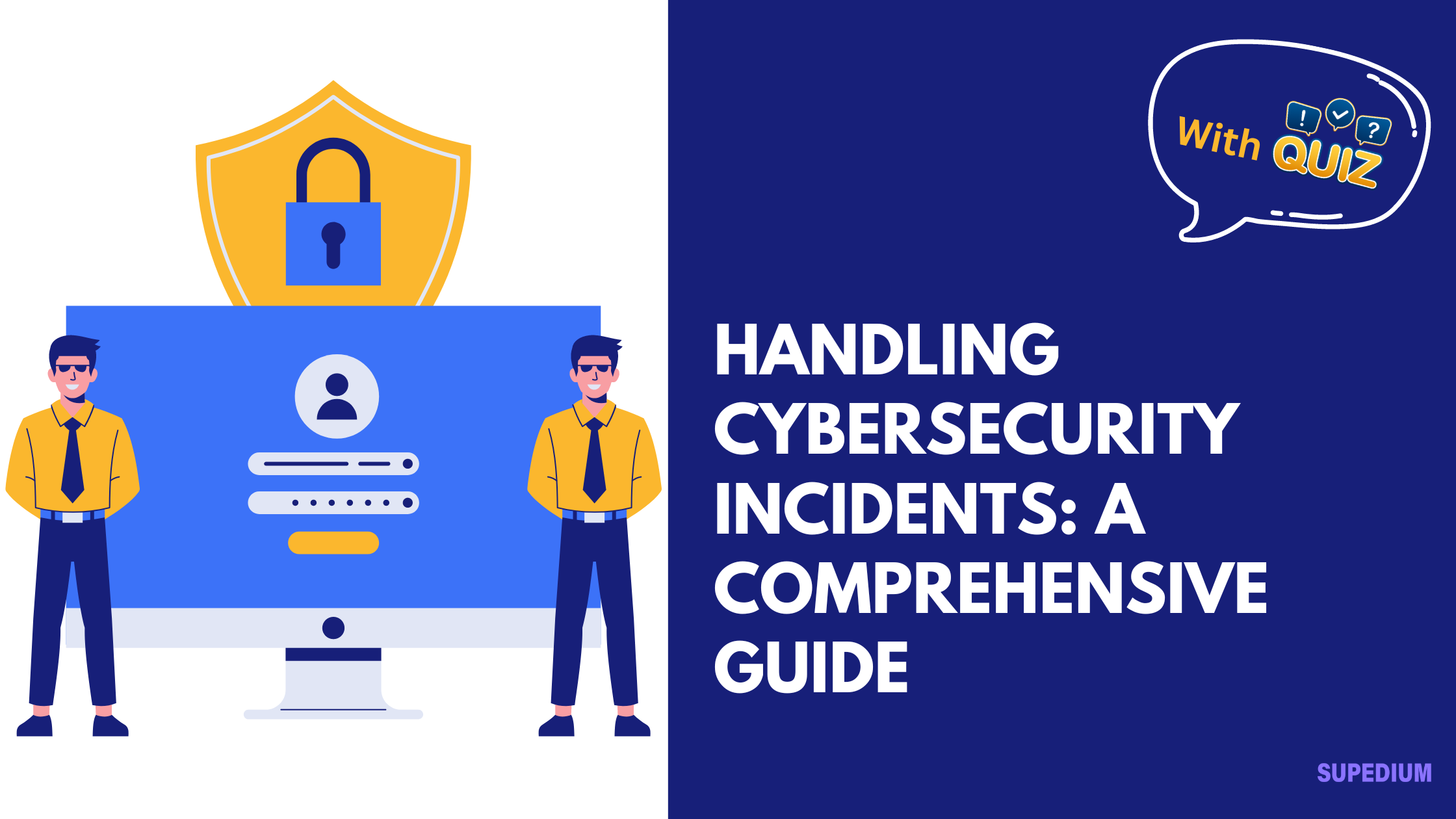Table of Contents
![]()
In today’s digital landscape, cybersecurity incidents are a significant threat to organizations of all sizes. An effective incident response strategy is crucial to mitigating damage, recovering swiftly, and protecting organizational assets and reputation. This article delves into the key components of handling cybersecurity incidents, providing a detailed guide on best practices and considerations.
I. Introduction
Definition of Cybersecurity Incident
A cybersecurity incident refers to any event that compromises the confidentiality, integrity, or availability of information or systems. These incidents can range from data breaches and malware infections to denial-of-service attacks and insider threats. Given their potential to cause significant harm, having a well-defined strategy to manage such incidents is essential.
Importance of Incident Handling
Proper incident handling minimizes damage, reduces recovery time, and helps organizations maintain their reputation. Moreover, effective response practices are crucial for compliance with legal and regulatory requirements, which often mandate timely reporting and mitigation of breaches.
II. Incident Response Framework
A. Preparation
- Incident Response Plan (IRP)
An Incident Response Plan (IRP) outlines the procedures to follow when a cybersecurity incident occurs. It defines the scope of response activities, assigns roles and responsibilities, and establishes communication protocols. The plan should be regularly reviewed and updated to adapt to new threats and organizational changes.
- Tools and Resources
Equipping the incident response team with the right tools is critical. This includes software for threat detection, forensic analysis, and incident management. Maintaining an updated contact list and clear escalation paths ensures swift action during an incident.
- Training and Awareness
Ongoing training and awareness programs are essential for preparing employees to recognize and respond to potential threats. Regular simulations and drills help to reinforce procedures and test the effectiveness of the IRP.
- Policies and Procedures
Establishing robust policies and procedures is foundational to effective incident management. This includes data classification, handling guidelines, and access control policies, which help in managing and securing information assets.
B. Detection and Identification
- Monitoring Systems
Continuous monitoring is vital for early detection of potential incidents. Intrusion Detection Systems (IDS) and Security Information and Event Management (SIEM) systems play a key role in identifying anomalies and suspicious activities in real-time.
- Anomaly Detection
Advanced anomaly detection techniques involve behavioral analysis and threat intelligence feeds to identify deviations from normal patterns. This proactive approach helps in recognizing potential threats before they escalate.
- Incident Classification
Once an incident is detected, it is crucial to classify it based on severity (low, medium, high) and type (e.g., malware, phishing, DDoS). Proper classification aids in prioritizing response efforts and allocating resources effectively.
C. Containment
- Short-term Containment
Immediate containment actions are necessary to isolate affected systems and prevent further spread of the incident. This may involve disconnecting compromised systems from the network and informing relevant stakeholders.
- Long-term Containment
Long-term containment focuses on implementing temporary fixes to mitigate the impact of the incident while maintaining continuous monitoring. This phase ensures that the incident does not recur during the recovery process.
D. Eradication
- Root Cause Analysis
Identifying the root cause of the incident is crucial for effective eradication. This involves analyzing how the breach occurred, understanding attack vectors, and determining vulnerabilities that were exploited.
- Removing Threats
The eradication phase involves cleaning up malware, removing malicious files, and patching vulnerabilities. Ensuring that all traces of the threat are removed is essential to prevent future incidents.
E. Recovery
- Restoring Systems
Once the threat is eradicated, systems can be restored to normal operations. This includes reinstalling and reconfiguring affected systems and validating their integrity to ensure they are free from threats.
- Monitoring Post-Recovery
Post-recovery monitoring is critical to ensure that systems remain secure and stable. Continued surveillance helps in detecting any residual threats and assessing the effectiveness of the recovery process.
F. Lessons Learned
- Incident Review
Conducting a thorough review of the incident is essential for understanding what happened and evaluating the response. This analysis helps in identifying strengths and weaknesses in the incident handling process.
- Documentation and Reporting
Detailed documentation of the incident, including timelines, actions taken, and outcomes, is crucial for future reference. Comprehensive reporting provides insights for stakeholders and regulatory bodies.
- Updating Plans and Procedures
Based on the lessons learned, the IRP and related procedures should be updated to address identified gaps. Implementing new preventive measures helps in strengthening the organization’s overall security posture.
III. Legal and Regulatory Considerations
A. Compliance Requirements
Organizations must adhere to industry-specific regulations such as GDPR for data protection or HIPAA for healthcare. Compliance often involves timely reporting of breaches and adherence to notification requirements.
B. Legal Implications
Handling evidence properly and preserving it for legal proceedings is essential. Coordination with law enforcement may be necessary, depending on the severity and nature of the incident.
C. Insurance
Cyber insurance policies can provide coverage for incident response and recovery costs. Understanding the scope of coverage and ensuring it aligns with the organization’s risk profile is important for financial protection.
IV. Communication Management
A. Internal Communication
Effective internal communication ensures that all stakeholders are informed and involved in the response process. Coordination between IT, legal, and executive teams is crucial for a unified approach.
B. External Communication
Communicating with customers, partners, and the public is vital to maintaining trust and transparency. Crafting clear and accurate messages helps manage the organization’s reputation.
C. Media Handling
Managing media inquiries requires careful planning. Crafting timely and accurate statements while addressing media questions helps control the narrative and mitigate potential reputational damage.
V. Advanced Topics and Emerging Trends
A. Threat Intelligence and Analysis
Leveraging threat intelligence feeds and collaborating with information-sharing organizations enhances the organization’s ability to anticipate and respond to emerging threats.
B. Automation and Orchestration
Automation tools can streamline incident response activities and improve efficiency. Integration with existing systems ensures a cohesive and responsive security posture.
C. Artificial Intelligence and Machine Learning
AI and machine learning technologies are increasingly used for threat detection and anomaly identification. These advanced tools offer enhanced capabilities for recognizing and responding to complex threats.
D. Zero Trust Architecture
Implementing a zero-trust approach, which involves continuously verifying all users and devices, enhances security and reduces the risk of insider and external threats.
VI. Case Studies and Real-World Examples
A. High-Profile Cybersecurity Incidents
Analyzing major breaches such as the Equifax data breach or the Colonial Pipeline ransomware attack provides valuable insights into the challenges and best practices for incident handling.
B. Lessons Learned from Past Incidents
Examining past incidents helps in understanding common pitfalls and effective strategies for response and recovery. Key takeaways can guide improvements in incident handling processes.
VII. Conclusion
A. Summary of Key Points
Handling cybersecurity incidents requires a structured approach that encompasses preparation, detection, containment, eradication, recovery, and post-incident analysis. A well-defined incident response framework helps organizations manage and mitigate the impact of cybersecurity threats effectively.
B. Final Recommendations
Regularly updating the Incident Response Plan, investing in employee training, and adopting advanced technologies are essential for maintaining a robust cybersecurity posture. Continuous improvement and adaptation to evolving threats ensure that organizations are well-prepared for future incidents.
By implementing these practices, organizations can enhance their ability to handle cybersecurity incidents, protect their assets, and ensure long-term resilience in an increasingly complex threat landscape.






Be the first to comment